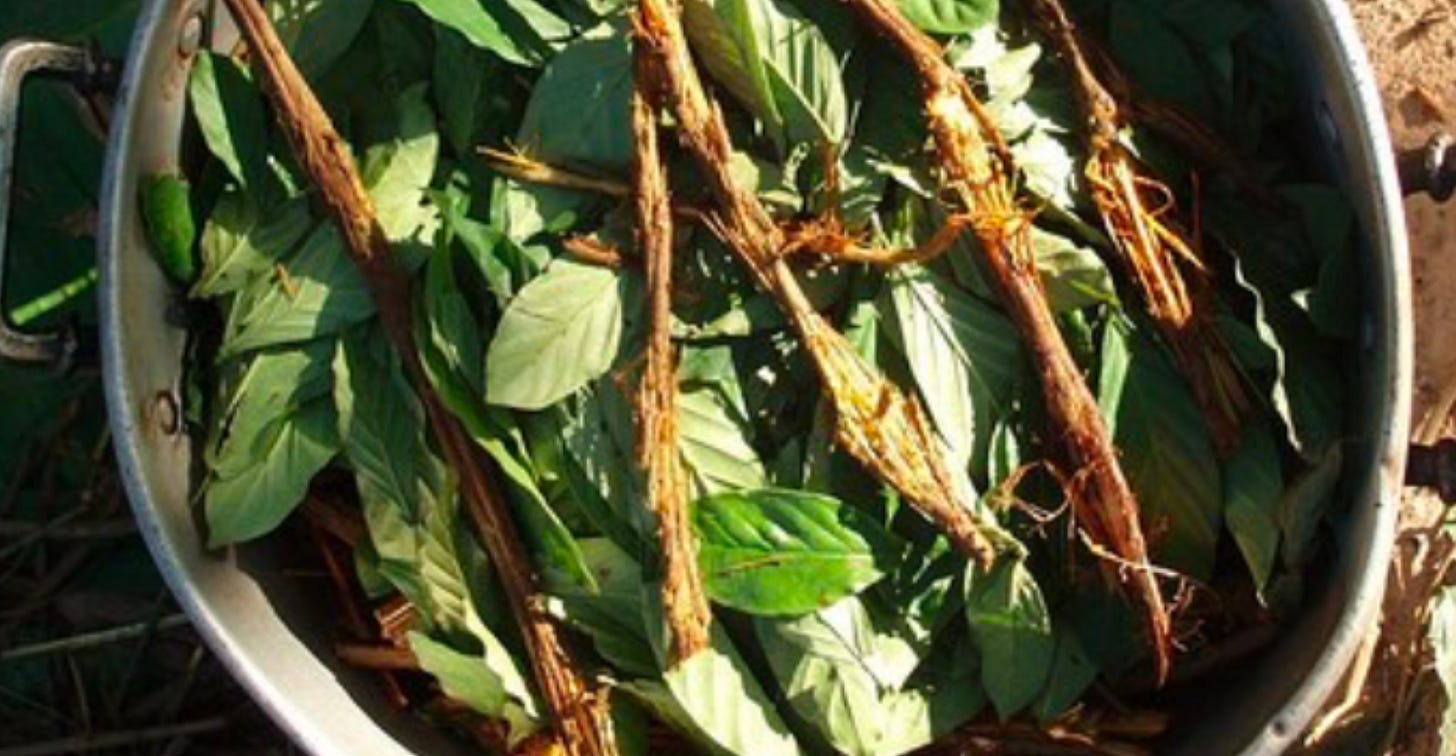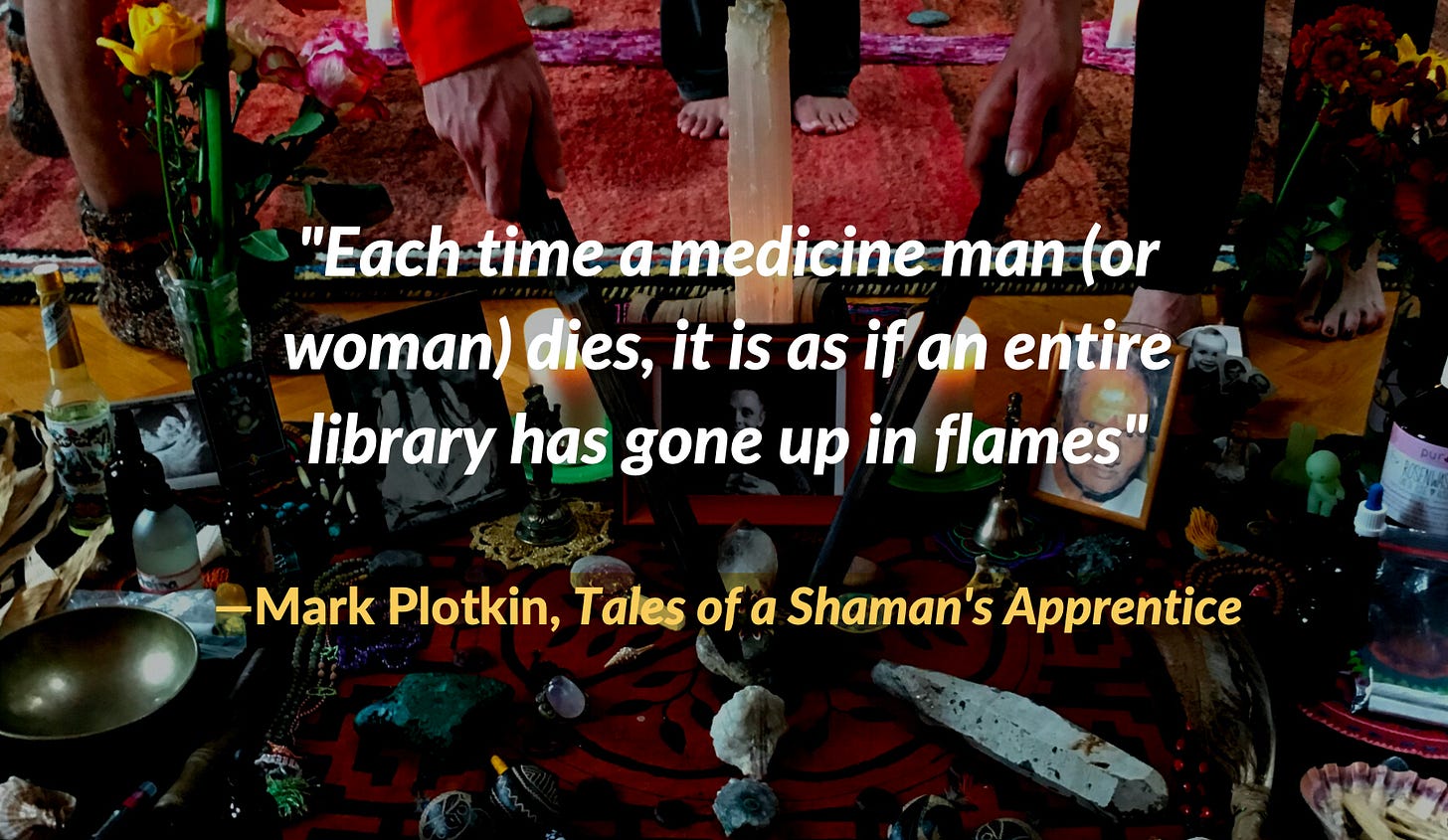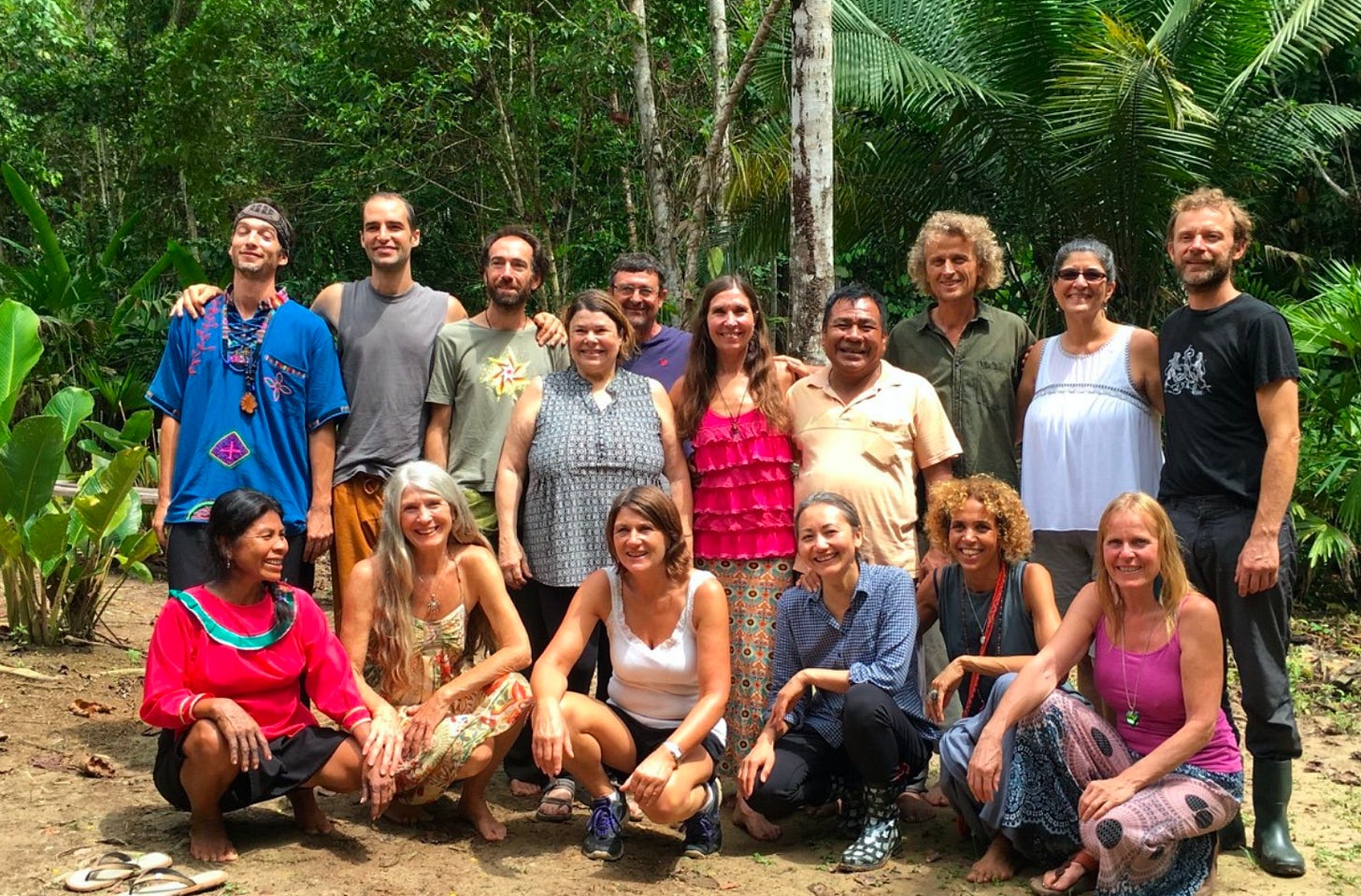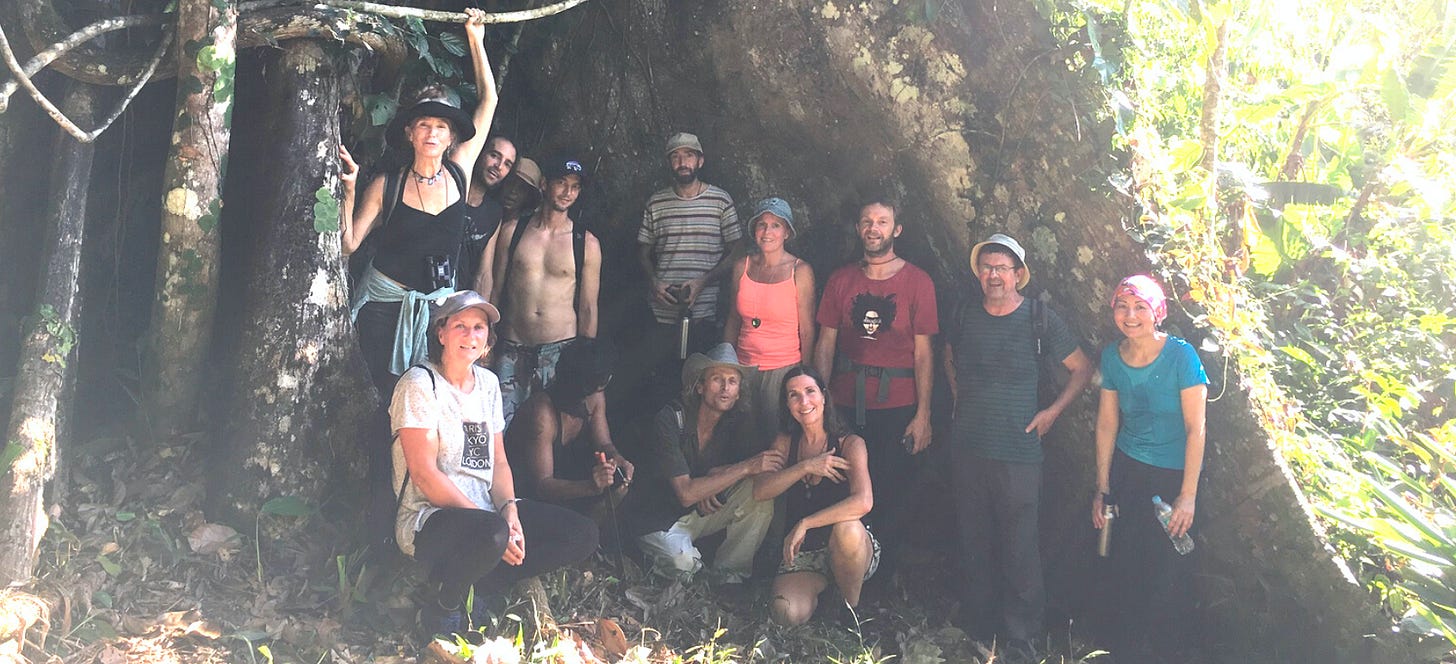When a good friend invited me to an Ayahuasca ceremony, I flung in earnest. My life had become unrecognizable to me. I was exhausted with chronic fatigue, when I slept it was fitful or interrupted—I felt like a ghost in my own home. This wasn’t good because my children needed me—I needed me. Somehow I managed the essential chores of daily living such as feeding, bathing, and changing diapers, along with a slew of medical procedures for my tiny fragile twins. I was utterly done in, shot, spent, whipped to the gill, and willing to chance traveling across the globe to the Amazon Basin of Peru to drink Ayahuasca.
Ayahuasca is an entheogenic brew made of Banisteriopsis caapi vine, often in combination with other plants. The word "Ayahuasca,” is from the Quechua language, and means "vine of the soul." I discovered it to mean “to purge” a lot!
For centuries, Amazonian medicine people have used Ayahuasca as a window to the soul. The plant contains N-dimethyltryptamine (DMT), a psychedelic tryptamine compound found in the human body and at least 60 species of plants worldwide. Rick Strassman described Ayahuasca as “the first endogenous human psychedelic” in his book DMT, The Spirit Molecule. Terence McKenna’s lectures, books, interviews, and recordings continue to raise awareness of DMT and lure troves of people to drink the dark mysterious brew.
My first encounter with Ayahuasca was off the grid in the States with an American shaman. I thought—no big deal. We listened to relaxing spiritual music, vomited in buckets, rested on a threefold yoga-type mat, and slept until sunrise. It was a lovely experience. I had a good night's sleep and felt lighter but no major changes.
A few years later, in 2010 when I flew to Iquitos, Peru, and traveled with ten other passengers in a shabby skinny boat down the majestic Amazon River through winding tributaries teeming with anacondas deep into the jungle to drink Ayahuasca with the Shipibos—I was blown away.
After a thirty-minute trek through deep mud, we arrived at the retreat center and were welcomed by three Shipibo women wearing traditional wrap-around skirts laced with intricate designs and patterns. They situated us at a ledge and urged us to guzzle at least a liter of lemongrass water. The objective was to clear heavy energies from our bodies in preparation for receiving their medicine. The Shipibo women stood behind our weary, belching bodies, ready to grab any of us around the waist to help with the purge.
Drinking Ayahuasca is considered one part of the total healthcare system practiced by the Shipibos for centuries. We were instructed to follow a two-week preparation diet before arriving that included live vibrant food and excluded processed, spicy, or fermented foods, red meat and pork, dairy products, medications, sexual activity, alcohol, drugs, and other precautions to minimize adverse effects, increase sensitivity, to prepare mentally, emotionally, spiritually and physically, to show respect for the tradition, and to optimize safety.
If these preparations are not required, it is best to find a qualified medicine man or woman who ensures a safe experience and practices in alignment with an indigenous tradition.
At the time, I didn’t know that this first meeting with Maestro Jorge and Maestra Sulmira was my initiation as an apprentice into their ancient Shipibo tradition.
We met for seven ceremonies stretched out over twelve days. They took place in a Maloka, a screened structure shaped like an octagon lined with a mahogany wooden floor and covered with a thatched roof. When I entered the Maloka I nearly fainted from the intense scent of pusanga (a mixture of aromatic oils, plants, and agua florida) and thick clouds of Peruvian tobacco smoke. I crawled to my mat, covered my head with a blanket, and shook like a rattle. Later I learned that the smoke of tobacco along with pusanga protects the ceremony space and cleanses negative energies. It took a while but I came to appreciate this aspect of the ritual. Once all twenty participants were covered in smoke and settled in their places we were invited one by one to drink a shot glass of the dark brew—Ayahusaca.
As the night darkened, a symphony of melodic chirps and guttural croaks of night frogs imploded from the jungle, heightening our eager yet slightly foreboding expectancy of the medicine rising in our bodies. The onset after ingestion varies for everyone, typically occurring within twenty to sixty minutes. For me it was immediate. It tasted like coffee grounds, I wanted to spit it out but I didn’t, I plugged my nose and swallowed. It wasn’t long before I felt tingling, heat, and I don’t know what—surge through my body.
On that first night, I gathered three vital lessons: never trust a fart, purging happens in multiple ways, and I can be loud. When I wasn’t sitting on the toilet, simultaneously purging out of both ends, I was spread out on my mat yawning without pause. I was certain my jaw would break.
Throughout the ceremony, five different Shipibo Curanderos scooted around the Maloka on their butts from participant to participant to sing an Ikaro. Ikaros are sung (loudly and concurrently by all five maestros) to guide us through spiritual realms and help facilitate healing and the flow of the Ayahuasca journey. The songs communicate with the spirit world and call upon plant spirits, and other guides for assistance, protection, and guidance during the ceremony.
The intensity of the medicine usually plateaus after two hours, often characterized by a deep inner journey, as if you are traveling within your mind, exploring early memories, processing emotions, and experiencing ongoing visuals. On that first night, I mostly purged, yawned, or covered what I thought were my ears to turn down the volume of a foreign quadraphonic concert that seemed to be taking place inside my unlocatable body.
The effects of Ayahuasca gradually start to diminish after four to six hours. Visuals become less intense, physical sensations begin to normalize, and you wonder, “What just happened, where am I, what the F**k was I thinking?”
This retreat was not easy. But even after the first night, I felt heavy rocks, rigidity, and fatigue leave my body. Feelings that must have been frozen began to thaw. One day I slept so long that I nearly missed the evening ceremony. I participated in all seven ceremonies, no two ceremonies were alike. I remember feeling absorbed in deep reflections, reconciling earlier conflicts, weeping, or chuckling out loud. In one ceremony, I had my first ever long conversation with my estranged dead father. Later, I was quiet inside, an inner peace I had not felt in years. My chronic fatigue was healed. My dreams became vivid and informed my waking life.
In many ways, it was as if the spirit of the plants performed surgery on my physical, emotional, mental, and spiritual bodies that held trauma from the abrupt C-section intervention to my womb for a premature excavation of my one-pound babies. That ginorous trauma left me dumb and disconnected from essential parts of who I am, especially the power below my waist. I felt my legs again—feet solid on the ground like I grew roots and became more like a great mother tree.
I am not exaggerating when I say the special care, wisdom, and the dark brew from the Shipibo’s rebirthed my life—my wholeness. When I returned home after this life-giving journey, one of the first people I saw was my oldest daughter. She was sixteen at the time. After a long gaze of amazement, she said, “Mom, something is different about you, and I want it!”
Be careful what you ask for. For her eighteenth birthday, I brought her with me to Peru. We visited Machu Picchu, explored the Incan ruins, and traveled through the Sacred Valley. We ended our three-week excursion with a twelve-day retreat at the temple of the Shipibos for seven ceremonies in the dark, to drink the dark brew. This is a story for another time and perhaps one for her to share if she wants to.
In the following years, I would take up the essential work of practice and integration to nourish the tree I was becoming and fortify my capacity to attend to the ongoing aftermath of unexpected trauma in our family.
My respect for the Shipibo way of life captured my devoted attention. I had many questions, concerns, and disappointments with Western medicine. I would return to Peru often. In retrospect, given the ongoing urgencies within our family, I have no idea how I did. I began a course of ‘dietas’ that would continue for ten years. A disciplined diet in seclusion, deep in the jungle without human interaction, only you, your Maestro(a), the wisdom of the plants and wild nature—learning and receiving the healing properties of one plant at a time. Essentially, through the practice of dieta, your body integrates and carries the spirits of the plants. I earned the trust and friendship of Maetro Jorge and Maetra Sulmira. They invited me to work alongside them. I helped them establish a family retreat center named Jakon Nete (which translates as beautiful life/world and living in harmony with oneself, others, and the natural world.) Each year, I brought groups of ten or sixteen people to receive the healing benefits of Ayahuasca in ceremonies with Jorge, Sulmira, and their families.
I’ve been learning, healing, and growing with Ayahuasca for over fifteen years. Jorge and Sulmira have blessed me countless times to carry this medicine. I will always be an apprentice to their culture. It does not belong to me but is one I hold in the highest regard and contains volumes of ancient wisdom all people can benefit from.
Dr. Mark Plotkin, an ethnobotanist known for his advocacy throughout the Amazon rainforest, emphasizes the critical importance of preserving the land, the traditional communities, and the knowledge of indigenous healers.
Each time a medicine man or woman dies, it is as if an entire library goes up in flames.
— Dr. Mark Plotkin, Tales of a Shaman's Apprentice.
Ayahuasca is not a magic cure that heals all hardship, trauma, and suffering overnight. It’s a healthcare system and a journey that requires a bonified medicine healer, skillful administration, attention to preparation, safety, and informed content. Not all people who claim to be ‘shamans’ are medicine people that bring light and healing.
As a species, we are at a critical time in our history (again), a practice of communing with plants and nature does not mean you have to drink Ayahuasca. There are many healing paths and ways to contribute to preserving our planet and living in harmony with life. Plant medicine is a catalyst for undergoing a dramatic life change with extensive healing that includes meeting hidden parts of yourself (shadow) and requires ample preparation—it is not safe for everyone. All plants reflect a way of being that is kind, curious, and non-judgmental—a free resource available for all to benefit from.
“Prajna’s skill and intuitive wisdom of the plants guided me to break through a block I have suffered from for years. I experienced healing deeper than before. I’m renewed with clarity and strength to stand in my power. Immense gratitude for her capacity to support us to deep connection and inner peace.” — Tara Castleberry
This essay came as I was preparing for several upcoming retreats. I’ve been facilitating retreats that combine body-centered therapeutic processes, story healing, and dreamwork with plant medicine since 2017 with the exquisite guidance of my Shipibo mentors. In future essays I will write more about my apprenticeship; the spirit of the plants; Sacred Peruvian Tobacco; how I work with the plants in combination with additional resources; the benefits and precautions; remarkable healing stories from participants; why and how I work with this medicine, and my official crowning as an American Curandera.
“Prajna has my full trust. I have never felt safer. She creates a sacred space to dive deep into our humanness with joy to clear unconscious material. Her limpias (healings) are like nothing I’ve experienced with other guides. I emerge with more clarity, safely grounded in this body.”
— Ariana Wohlstatta
Thank you for reading and receiving your dose of The Salty Crone.
with love,
Prajna O’Hara @PrajnaOhara.com
If you enjoy this publication, please consider restacking or sharing with friends. I do not have a paid subscriber option at this time. I am in the process of preparing additional benefits for community engagement.
Thank you for being here!












That’s a wonderful insight. I have some of those fabrics.
Where do you live?
By now, at eighty-two, I feel pretty whole, but this is so different from anything I have known or have felt that it tempts me.